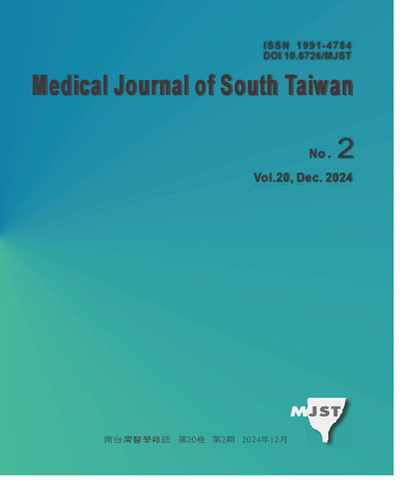
南臺灣醫學雜誌/Medical Journal of South Taiwan
阮綜合醫療社團法人阮綜合醫院,正常發行
選擇卷期
- 期刊
白斑症是一種常見的色素脫失性疾病。白斑症的特徵主要是皮膚出現界線鮮明、形狀不規則的白色斑塊;雖然白斑症不是致命的疾病、也不會傳染,但卻會影響美觀,對患者造成非常大的心理困擾,一般人當中大約有1-2%的人患有白斑症,大約20%有家族遺傳病史;白斑症又可以區分為分節型白斑症與全身型白斑症等類型。臨床上有許多皮膚脫色素疾病容易和白斑症混淆,包括:汗斑、白色糠疹、突發性水滴狀黑色素減少症、化學性白斑症等,類結核型漢生病早期症狀為皮膚出現紅色或白色斑塊、丘疹或小結節,患處感覺喪失;但在很早期時皮膚感覺可能是正常的。需要經由醫師的評估,才能做出正確診斷,有時候臨床醫師會需要透過皮膚病理切片檢查,排除黑色素細胞減少或缺失的惡性疾病。
- 期刊
目的:新型冠狀病毒疫情期間,使用外科口罩對於頭頸癌的病患在接受放射治療中位置的準確性。方法:收集32位由2021年1月至8月頭頸癌病患使用S-type固定模具進行放射治療,治療時佩戴外科口罩型號為一般醫用外科口罩(未滅菌),規格為17.5cm × 9.15cm,並從影像導引定位系統(X-Ray Volume Imaging; XVI)得出擺位誤差影像之位移數據,最後用獨立t檢定分析對有否用外科口罩於各軸向擺位誤差是否有差異性存在。結果:21位沒有使用外科口罩的病患的平均位移為0.8±0.7mm、1.2±1.0mm、0.8±0.8mm,代表x,y,z方向,而11位的病患使用外科口罩的平均位移為0.8±0.8mm、1.8±1.0mm、1.3±1.1mm代表x,y,z方向,兩者實質上並無統計上的差異(p值>0.05)。結論:頭頸癌病患使用S-type固定並在疫情期間佩戴外科口罩進行放射治療是可行的,既能保護醫療同仁的安全及不造成病患治療準確性之差異。
- 期刊
A 76 year-old male with prior medical history of hypertension, minor stroke, and mild dementia was admitted to our hospital because of bradycardia and hypotension requiring dopamine and norepinephrine for hemodynamic support. Chest X-ray showed borderline cardiomegaly and bilateral pleural effusion. Abdominal ultra-sonography showed a hepatic lesion over S6, which was suspected to be a hematoma or space occupying lesion. Computed tomography revealed liver laceration (7 cm in depth) in S6 with hemoperitoneum, and fractures of the right 7th-10th ribs with hemothorax. After our aggressive treatment including chest tube drainage and transarterial embolization to his laceration, patient's general condition improved gradually. He was discharged after 25 days of hospitalization. Patient's dementia and bilateral pleural effusion might be the possible causes to the delay diagnosis of the liver laceration and rib fractures. We hereby report our experience in managing this case.
- 期刊
Gallbladder torsion is a rare but life-threatening emergency. Complete torsion may rapidly progress to gangrene, perforation, and death. Therefore, prompt surgical management is important. However, the diagnosis is challenging because gallbladder torsion present the signs and symptoms as cholecystitis. This condition is often identified intraoperatively. We described a 76-year-old woman presented with sudden-onset, severe abdominal pain. On physical examination, she was afebrile with marked tenderness in the right upper quadrant. Laboratory data showed normal white cell count and biochemistry. Computerized tomography demonstrated calculus of the gallbladder with thickened wall and dilatation of the biliary tracts. She was admitted under impression with acute calculous cholecystitis and was treated conservatively. Due to exacerbation of pain, we arranged emergent operation on the third day. Intra-operatively, the gallbladder was found 360 ◦ counterclockwise torsion along the cystic pedicle resulting in gangrenous change. After unraveling clockwise, chole-cystectomy was performed smoothly. The postoperative course was uneventful, and she was discharged smoothly 14 days after operation.
- 期刊
Disseminated Klebsiella pneumoniae (K. pneumoniae) infection has dismal outcomes and is a common pathology in Taiwan, often leading to pneumonia and urinary tract infection. K. pneumonia-related liver abscess is common in diabetes mellitus patients. However, acute pyogenic K. pneumoniae abscesses are rare in the kidney and peri- and paranephric spaces with simultaneous abscess extension to the spleen, iliopsoas muscle, and flank abdominal wall. A 63-year-old man was taken to the emergency room owing to a one-week history of dysuria, malaise, and pain in the left abdomen and left flank. The patient had no known medical history or contact history related to contagious disease. Imaging diagnostics revealed splenic, renal, and perinephric gas-forming abscesses. Blood, urine, and pus culture yielded K. pneumoniae. A final diagnosis of K. pneumoniae septicemia and septic shock associated with a left perirenal abscess extending to the left iliopsoas muscle and left flank abdominal wall was made. The patient was successfully treated with percutaneous drainage for the abscesses and a one-month course of broad-spectrum antibiotic treatment. Percutaneous drainage is an effective approach to remove abscesses and when combined with broad-spectrum antibiotics, sepsis can be controlled effectively.
- 期刊
Cerebral salt wasting (CSW) is not rare in the elder after traumatic brain injury(TBI). An emergency may develop once mental disturbance, seizure and respiratory distress happened. The mechanism of chronic subdural effusion (cSDE) induced CSW remains in a hypothetic status. We reported a 91-year-old man with a normal health for the past 40 years. He was first present at the emergent department owing to a TBI one month ago. This is his secondary visit due to progressively sleepy, weakness and stupor. The head computerized tomogram revealed bilateral frontal subdural effusions without significant mass effect. Laboratory data shew Na^+=119meg/dL; estimated glomerular filtration rate (eGFR)=57.9ml/min/1.73 and urine specific gravity (Uspgr)=1.003. He was then admitted to nephrotic ward. After intravenous administration of hyperosmotic saline for one week, his serum Na^+ was around 120 to 126meq/dL and consciousness levels befell inattention. A CSF shunt was performed. Thereafter, the serum Na^+= 134meq/dL; eGFR=69.2/ml/min/1.73 and urine Uspgr=1.010. The patient was discharged with alert status one week postoperatively. This study lends credence to support hyponatremia secondary to cSDE induced CSW, may lead to lethal morbidity, optimal surgical management and adjuvant fluid therapy leads a better result in this kind of cases.
- 期刊
「全人健康照護」是一個內含複雜現象與許多交織性因素構成的用詞,現今全人照護都以包括病人為中心與全人為醫療照護實作(praxis)的概念,此兩個並存概念濫觴於西方全科醫療服務的醫療照護(general practice)之核心價值,導致在臨床教育與實務上都可能對全人照護產生有限或不正確的理解。希望能藉由「全人照護中的全人」、「以病人為中心的概念」及「全人與病人為中心概念之並用」等三部分來論述,討論「全/人」複合的意義,剖析了以人為「中心」與「全」之概念。以闡明與釐清全人照護的意涵,希冀這樣的建議能讓未來健康照護服務提供者與教育者,在從事健康照護實踐及臨床教育時,闡明與釐清全人照護的意涵,清楚與正確使用此一名詞。

